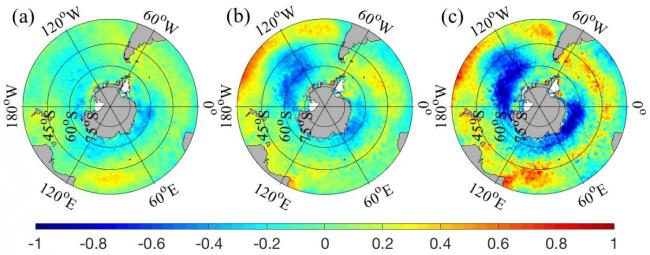Teleconnections in the Southern Ocean
The Southern Ocean is a highly dynamic component of the global ocean circulation and plays a crucial role in the transport of heat, uptake of carbon, and global climate system. Due to its global importance and highly variable climate, the Southern Ocean is the focus of many physical, chemical, and biological studies.

The Southern Ocean lacks high spatial and temporal resolution of in situ observations – driven in part by the harsh austral winter conditions – meaning satellite products serve to help fill this gap. In a paper published in Remote Sensing, Fester and colleagues investigate the relationship between large-scale atmospheric patterns, commonly referred to as teleconnections, and satellite-derived sea surface temperature (SST).
Using satellite observations from 1982–2017, the researchers looked at the spatial correlations between SSTs and global atmospheric teleconnection patterns (using standardized anomalies to account for the strong seasonality of the Southern Ocean). They found SSTs to be significantly correlated to both the Antarctic Oscillation and the Southern Oscillation, with correlations between the indices and standardized SST anomalies spatially approaching ±1.0. The findings show that the recent positive patterns in the Antarctic and Southern Oscillations are driving high-latitude negative trends in SST (cooling) and positive trends (warming) in the sub-tropics and mid-latitudes of the Southern Hemisphere. The coefficient of regression over the 35-year period analyzed implies that standardized temperatures have warmed at a rate of 0.0142 per year between 1982 and 2016, with a monthly standard error in the regression of 0.0008. Further regressions between the indices and SST indicate strong seasonality in response to changes in atmospheric circulation, with the strongest feedback occurring throughout the austral summer and autumn.
In summary, large-scale spatial patterns of both the Antarctic and the Southern Oscillations are significantly correlated to SST in the Southern Ocean, driving significant cooling in the high-latitude Pacific basin. The study determines that recent positive trends in these teleconnection patterns are simultaneously driving cooling in Antarctic sub-polar regions and warming in the Southern Hemisphere subtropics.
1 University of South Carolina
2 Woods Hole Oceanographic Institution
Topics
- Southern Ocean
- Satellites
- Air-Sea
